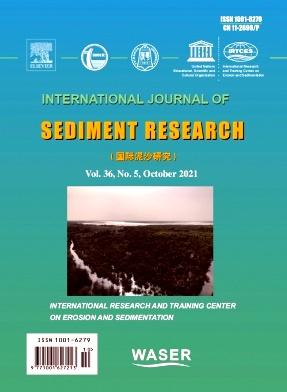Formation condition for concave-bank deposition in the meanders of the Middle Yangtze River and its application
IF 3.7
2区 环境科学与生态学
Q2 ENVIRONMENTAL SCIENCES
引用次数: 0
Abstract
In what kind of meanders concave-bank deposition (CBD) can occur remains an open question. This study investigated the characteristics and major influencing factors of CBD in the meanders of the Middle Yangtze River (MYR), and proposed a formation condition for CBD. Concave-bank deposition occurred in 10 of 23 meanders in the MYR, including two types: counter point bar (CPB) and concave-bank bench (CBB). CPB occurred in both mildly-curved and sharp bends, while CBB only occurred in sharp bends. Hydrodynamic conditions and sediment supply are two major factors controlling the formation of CBD. The incoming sediment load remained in an amount of 0.68 × 108 t/y at Jianli and 0.77 × 108 t/y at Luoshan after Three Gorges Project operation, therefore, CBD development was not limited by a lack of sediment and instead is mainly dependent on the hydrodynamic conditions in the MYR. Flow separation zones were observed in the typical CBD-type bends of the MYR, which indicated that CBD was the result of flow separation or recirculation. An adverse longitudinal water surface gradient is the necessary condition for the formation of concave-bank flow separation. Therefore, a formation condition for CBD was proposed based on this assumption, which considered the combined effects of channel resistance, riverbed slope, channel widening, and curvature. CBD happens when the channel widening and curvature terms are greater than the channel resistance and longitudinal channel slope terms. The proposed condition was verified based on the data of the 23 bends in the MYR and 26 bends in 12 other rivers. The results indicated that more than 85% of the bends were correctly identified. Therefore, the proposed formation condition provided considerably high accuracy.
长江中游河道凹岸沉积的形成条件及其应用
在什么样的河曲中会出现凹岸沉积(CBD)仍是一个未决问题。本研究探讨了长江中游河曲凹岸沉积的特征及其主要影响因素,并提出了凹岸沉积的形成条件。在长江中游 23 条河道中,有 10 条河道出现了凹岸沉积,包括两种类型:反点条形沉积(CPB)和凹岸台形沉积(CBB)。CPB 出现在轻度弯曲和急弯处,而 CBB 仅出现在急弯处。水动力条件和泥沙供应是控制 CBD 形成的两个主要因素。三峡工程运行后,监利和罗山的泥沙入库量分别保持在 0.68×10 吨/年和 0.77×10 吨/年,因此,CBD 的发育并不受制于泥沙的缺乏,而主要取决于多年河道的水动力条件。在马家河典型的 CBD 型弯道中观察到了分流区,这表明 CBD 是分流或再循环的结果。不利的纵向水面梯度是形成凹岸分流的必要条件。因此,根据这一假设,考虑到河道阻力、河床坡度、河道加宽和曲率的综合影响,提出了 CBD 的形成条件。当河道加宽和曲率项大于河道阻力和河道纵坡项时,就会出现 CBD。根据马约河 23 个弯道和其他 12 条河流 26 个弯道的数据,对提出的条件进行了验证。结果表明,85% 以上的弯道被正确识别。因此,所提出的形成条件具有相当高的准确性。
本文章由计算机程序翻译,如有差异,请以英文原文为准。
求助全文
约1分钟内获得全文
求助全文
来源期刊
CiteScore
6.90
自引率
5.60%
发文量
88
审稿时长
74 days
期刊介绍:
International Journal of Sediment Research, the Official Journal of The International Research and Training Center on Erosion and Sedimentation and The World Association for Sedimentation and Erosion Research, publishes scientific and technical papers on all aspects of erosion and sedimentation interpreted in its widest sense.
The subject matter is to include not only the mechanics of sediment transport and fluvial processes, but also what is related to geography, geomorphology, soil erosion, watershed management, sedimentology, environmental and ecological impacts of sedimentation, social and economical effects of sedimentation and its assessment, etc. Special attention is paid to engineering problems related to sedimentation and erosion.

 求助内容:
求助内容: 应助结果提醒方式:
应助结果提醒方式:


